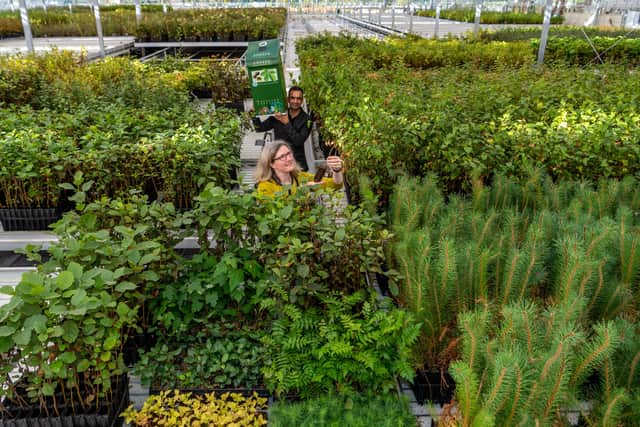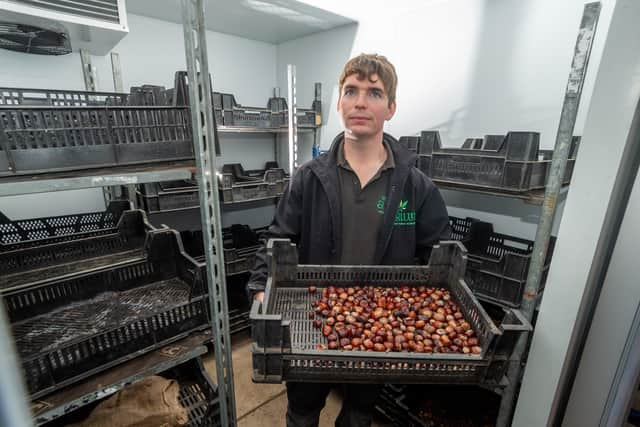Nuts to conkers as Leeds squirrels away the fruits of autumn
Health and safety considerations had long hung over the practice of drilling a hole through the seed of a horse chestnut tree and using it as a weapon to attack a bigger one strung up by a rival player.
But the current restriction on mixing between different households in certain parts of the county has made the prospect of declaring a champion in the quintessential British autumn pastime of conkering even less likely.
Advertisement
Hide AdAdvertisement
Hide AdHowever, conservationists in Yorkshire’s largest city say they have found a more fruitful use for this year’s windfall, and for the acorns, beech nuts and chestnuts that would also have been otherwise raked up.


Instead of bashing, binning or burning them they will be gathered by squirrel-like volunteers, stored in collection boxes and then grown into saplings which will form the roots of at least 250 acres of new woodland.
The first collection points were declared open by the city council yesterday at the start of an initiative which will see 5.8m trees planted over the next 25 years, with the first 220,000 ready for this winter.
The incubator at the heart of the project is the Arium, a 200,000 sq ft glasshouse on the outskirts of Thorner, just off the A64.
Advertisement
Hide AdAdvertisement
Hide AdIt is the biggest council-run growing nursery in the country and produces 3m plants every year, covering 500 species.


The authority says putting it to use propagating new trees, an idea it conceived before the pandemic, will reduce the carbon footprint in a city that was claimed last year to include the most polluted street outside London.
The new trees will also create new habitats for wildlife, said Mohammed Rafique, the council’s executive member for the environment.
“Being actively involved in the creation of these woodlands represents a unique opportunity to support the city’s carbon neutral ambitions, and I hope many residents will take advantage of it,” Councillor Rafique said.
Advertisement
Hide AdAdvertisement
Hide AdThe council says the project – which will double the coverage of woodland in the city – will contribute towards its ambition of making Leeds “carbon neutral” in 10 years, and will form part of the White Rose Forest, a joint venture with other local authorities, which traverses the south Pennines.
Leeds has been the subject of intense scrutiny by climate campaigners, with parts of Neville Street, near the train station, reported by Friends of the Earth to have a nitrogen dioxide level of more than twice the recommended limit.
Lisa Mulherin, the council’s executive member for climate change, said the campaign to encourage people of all ages to collect seeds this autumn, within their own households or support groups, was “a great opportunity” for members of the public to become involved in cleaning the environment.
“I hope that residents across the city will get involved in a safe socially distanced way by collecting tree seeds while enjoying the many green spaces Leeds has to offer,” she said.
Advertisement
Hide AdAdvertisement
Hide Ad“We are committed to creating new woodlands across Leeds for all to enjoy, and see large-scale tree planting initiatives like this one playing an important part in our city becoming carbon neutral by 2030.”
Park rangers will hold a series of events over the autumn, including seed gathering workshops for schools and volunteer groups, as well as winter tree planting sessions.
A dozen collection boxes for the fruits of the season have been posted across Leeds, and can be found at Farnley Hall, Golden Acre Park, Gotts Manor tea room, Kirkstall Abbey, Meanwood Park, Middleton Park, Otley Chevin Country Park, Pudsey Park, Roundhay Park, Skelton Grange Environment Centre, Temple Newsam, and at the Arium, which is open to the public at Thorner Lane, Whinmoor.
Leaflets at each site help volunteers to identify the seeds which are most suitable for propagation.
Advertisement
Hide AdAdvertisement
Hide AdLeeds has nearly 10,000 acres of parkland, including seven large public parks and 63 smaller community recreation spaces. The largest, Roundhay Park, covers 700 acres to the north of the city.
Support The Yorkshire Post and become a subscriber today.
Your subscription will help us to continue to bring quality news to the people of Yorkshire. In return, you’ll see fewer ads on site, get free access to our app and receive exclusive members-only offers.
So, please – if you can – pay for our work. Just £5 per month is the starting point. If you think that which we are trying to achieve is worth more, you can pay us what you think we are worth. By doing so, you will be investing in something that is becoming increasingly rare. Independent journalism that cares less about right and left and more about right and wrong. Journalism you can trust.
Thank you
James Mitchinson
Comment Guidelines
National World encourages reader discussion on our stories. User feedback, insights and back-and-forth exchanges add a rich layer of context to reporting. Please review our Community Guidelines before commenting.